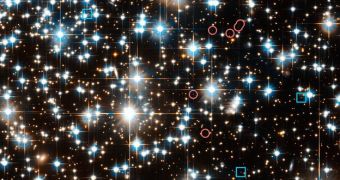New images captured by NASA's Hubble Space Telescope show how white dwarfs are kicked from the place of the original star, when they form. While observing the NGC 6397 globular star cluster, which consists of a dense accumulation of stars, Hubble has spotted a white dwarf traveling at relatively high speed. Most of the time, the stars that gather inside similar star cluster are thought to be massive and to end their lives as white dwarfs. Astronomers assumed that they would find a newly created white dwarf, right in the near vicinity of the center of the cluster.
However, during observations Hubble spotted a relatively young white dwarf, near the edge of the 11.5 billion years old star cluster. According to astronomer Harvey Richer, of the University of British Columbia in Vancouver, the distribution of white dwarfs in the NGC 6397 cluster is exactly opposite to what they have expected. Now, astronomers believe that the stars which evolve into white dwarfs are eventually propelled with a speed of about 3 to 5 kilometers per second, which ejects them out of the cluster.
The principle behind the stellar mass ejection is somehow similar to the principle of how rockets work. As the stars grow old, they deplete their fusion fuel and become unstable, expanding into a red giant star. In this process, the star loses about half of its original mass, by ejecting the outer layers. However, mass ejection is not always symmetric, as sometimes more is being ejected in only one direction, pushing the star in the opposite part.
This process can also be observed in the case of the planetary nebulae that are formed when red giant stars eject high quantities of matter, in only one direction due to certain unbalances inside the star.
Though the idea has been suggested over 30 years ago, only in 2003 a scientist from the University of California, named Michael Fellhauer, successfully calculated the amount of energy needed to boost a star out of an open stellar cluster. Nevertheless, the white dwarfs, which are formed deep inside the cluster, rarely get the chance to escape the cluster, as the gravitational field is at least 100 times greater then that of an open cluster.
Scientists decided to test the acceleration theory inside a star cluster, so they chose the closest star to Earth. Situated at only 8,500 light years away, NGC 6397 representd only one of the 150 globular clusters visible in our galaxy, each containing as much as a million stars.
Usually, globular star clusters sort their stars on the basis of the mass they have. Massive stars have a greater gravitational pull and gather towards the center of the cluster, while smaller stars pick up speed and move through the cluster towards the edges. However, the young white dwarf, discovered in the NGC 6397 star cluster, can be found in the outer edge, not in the center as astronomers hoped, suggesting a separate mechanism that would explain how the white dwarf got there, a kick for example.
Alternative theories involve the possibility that the white dwarf might have been part of a binary system and thrown off their orbit, by their companion star; or probably, it might have gotten a gravitational boot, while passing by massive stars. However, these scenarios are ruled out by computer simulations.

 14 DAY TRIAL //
14 DAY TRIAL //